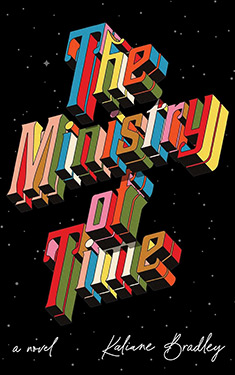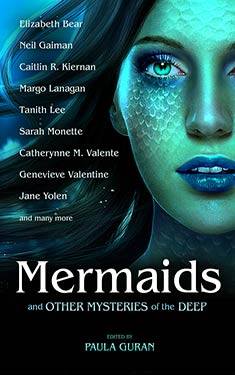Mermaids and Other Mysteries of the Deep
| Author: | Paula Guran |
| Publisher: |
Prime Books, 2015 |
| Series: | |
|
This book does not appear to be part of a series. If this is incorrect, and you know the name of the series to which it belongs, please let us know. |
|
| Book Type: | Anthology |
| Genre: | Fantasy |
| Sub-Genre Tags: | |
| Awards: | |
| Lists: | |
| Links: |
|
| Avg Member Rating: |
|
|
|
|
Synopsis
The sea is full of mysteries and rivers shelter the unknown. Dating back to ancient Assyria, folkloric tales of mermaids, sirens, rusalka, nymphs, selkes, and other seafolk are found in many cultures, including those of Europe, Africa, the Near East and Asia. Dangerous or benevolent, seductive or sinister - modern masters of fantasy continue to create new legends of these creatures that enchant and entertain us more than ever. Gathered here are some of the finest of these stories. Immerse yourself in this wonderful - and sometimes wicked - watery world!
CONTENTS
- Elizabeth Bear Bear - Swell
- Samuel R. Delany - Driftglass
- Neil Gaiman - The Sea Change
- Delia Sherman - Miss Carstairs and the Merman
- Margo Lanagan - Sea-Hearts
- Christopher Barzak - The Drowned Mermaid
- Genevieve Valentine - Abyssus Abyssum Invocat
- Seanan McGuire - Each to Each
- Sarah Monette - Somewhere Beneath Those Waves Was Her Home
- Peter S. Beagle - Salt Wine
- Caitlín R. Kiernan - The Mermaid of the Concrete Ocean
- Amanda Downum - Flotsam
- Cat Rambo - The Mermaids Singing Each to Each
- Anna Taborska - Rusalka3
- Chris Howard - The Mermaid Game
- Gene Wolfe - The Nebraskan and the Nereid
- Angela Slatter - A Good Husband
- A. C. Wise - Letters to a Body on the Cusp of Drowning
- Jane Yolen - The Corridors of the Sea
- Lisa L. Hannett - Forever, Miss Tapekwa County
- Catherynne M. Valente - Urchins, While Swimming
- Tanith Lee - Magritte's Secret Agent
Excerpt
Introduction: Waves
If there is magic on this planet, it is contained in water.--Loren Eiseley
Life on Earth began deep in the ocean and water remains the primary element needed to support that life.
We cherish water, but we also fear it--and for good reason: it can be unpredictable and dangerous as well as serene and beneficial. Our ancestors believed deities and spirits ruled the seas, the rivers, even the rain, lakes, springs, and wells. Appease the divine and, perhaps, you would be protected from the many aqueous perils... or not.
Powerful and incomprehensible, the oceans were thought to be the home of many monstrous creatures--sea serpents and dragons; the Norse Kraken, Greek Charybdis, Japanese Isonade, Biblical Leviathan. Rivers have monsters, too, like the Yacumama of the Amazon River or the malevolent zin, who live in the Niger River. As for lakes, even if you've never heard of the Welsh afanc, you know the Scottish Loch Ness monster.
The waters of the world were also believed to contain mythological creatures whose behaviors were as inconstant as our feelings about the mysteries of the deep. As Jane Yolen has said, "It is the allure of the beautiful, unattainable, mysterious Other. In every culture in every clime, there are stories of such creatures in the oceans, rivers, ponds, wells. Water is such a mutable, magical substance itself, the human imagination simply cannot believe it's not peopled as the earth is. We want there to be such underwater civilizations and--not finding them--we invent them and then turn around and believe in our own invention."
Tales have been told since ancient times of marine beings who were tricksters, brought misfortune, or lured humans to certain death. Some had wondrous voices, but to hear their enchanting songs or charmed speech could be fatal. Yet in other stories they were said to save sailors from drowning, grant wishes, or bestow treasure. Even if their actions were disastrous for humans, merfolk seem
amoral rather than evil. Since they are not human, why should they even comprehend our ideas of ethicality? Humans who understand such standards, often ignore them--especially when it comes to their conduct with mermaids, selkies, and others.
The seas were supposedly home for, among others, mermaids, mermen--usually, but not always, half human and half picine--sirens, the Nereids, and selkies. Other fantastic beings--like kelpies, naiads, morgens, rusalki, the Lorelei, the Nix, the Undine--were various nymphs, spirits, and shapechangers who inhabited rivers and lakes.
What is surely the best-known mermaid story, "Den lille havfrue" ("The Little Mermaid"), was written in 1836 by the Danish author Hans Christian Andersen. Published in 1837 in Denmark, it was translated into English by H. P. Paull in 1872. Despite its emphasis on Christian morality, pain and suffering, an unhappy ending, and a conclusion intended to frighten children, most of us seem to forget those aspects and remember it differently: the mermaid sacrifices her voice to persist in following her true love, who she marries and lives with (we assume) happily ever after. Maybe we read or heard bowdlerized versions, but many of us were thus impressed--unless we read or re-read the original Andersen story. When Disney's animated The Little Mermaid came along in 1989, we were happy
to accept Ariel, a rebellious and determined heroine who was, perhaps, not as independent as one might hope, but still no passive princess.
Earlier in the twentieth century, science fiction provided us with a new type of marine being: humans physically modified to breathe under water. And, skating somewhere between fantasy and science fiction, new concepts of undersea-living people--either related to humans or from a different genetic family altogether--arose. Human science has learned a great deal about the oceans, but we still have much to learn; there is still plenty of room to speculate.
And don't forget DC's comic-book superhero Aquaman. Since his creation in 1941, the character has had a wide range of incarnations and storylines, but his basic powers include the ability to live in the ocean depths, communicate with sea creatures, and swim at extremely high speed.
This anthology doesn't offer any of Aquaman's adventures or, for that matter, any finned red-haired teenagers wearing seashell bras. But it does present twenty-two wonderful fantasy and science-fiction stories involving many variations of merfolk. If there is any unifying theme beyond that, it may be transformation. Water is, after all, constantly changing.
Copyright © 2015 by Paula Guran
Reviews
There are currently no reviews for this novel. Be the first to submit one! You must be logged in to submit a review in the BookTrackr section above.
Images
No alternate cover images currently exist for this novel.



















 Full Details
Full Details






